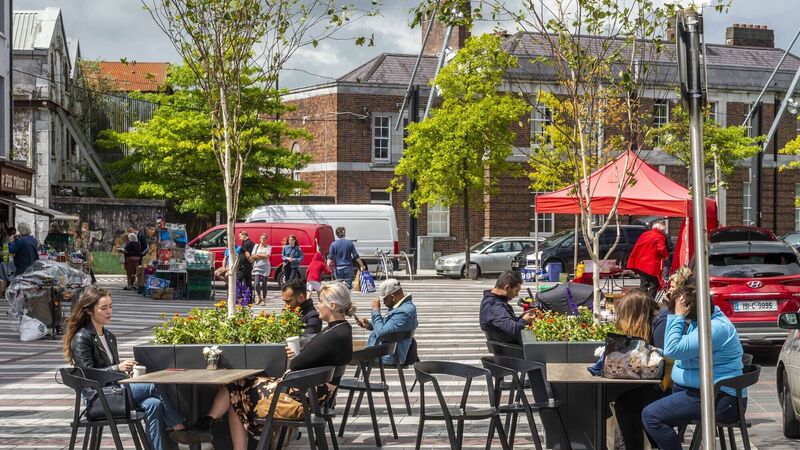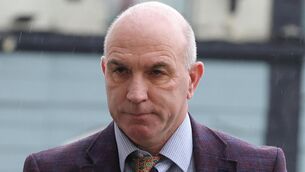Michael Moynihan: Your cup of tea? Coffee shops nourish the economy

It is one of the great asides in a book of great asides.
In , Leopold Bloom wonders about possible routes across Dublin, the capital: “Good puzzle would be cross Dublin without passing a pub,” he thinks, solidifying Dublin’s place in the imagination as a cityscape festooned with bars and speakeasies and saloons, so pub-heavy that some pubs have a pub hidden within them, a never-ending series of counters and beer pumps keeping regulars happy.
Based on my last visit to Dublin, months ago, it would be a better puzzle to cross the city without passing an upmarket barbershop. The other day, I wondered if this puzzle could be transferred to Cork: Not whether one could cross the city without passing a pub, but without passing a coffee shop.
I take a keen interest in the explosion in coffee culture on Leeside. This is partly explained by my brief spell as a barista in California — yes, seriously, the Mission Coffee Roasting Company of Fremont — and partly by what existed before the coffee culture: The Green Door; Mary Rose’s in the Queens Old Castle and Savoy; Tribes; An Stad; and the downstairs cafe in the old Roches Stores. After that, you were guessing.
Back then, it was possible to walk the streets of Cork without seeing a latte out of doors. I recall meeting a friend in the late 1980s, lately returned from New York, who left McDonald’s with a coffee in his hand.
Walking down the street, drinking coffee? Not a bother on him. Now, it’s different. Every 20 yards, from the Harbour Commissioner's to Finn’s Corner, there seems to be another coffee shop, dispensing cups and mugs and takeaways. Are there too many coffee shops? Are there too few? Is the number just right?
Hence my experiment, and my reference to the Harbour Commissioner's building, the starting point of this journey.
I ran into trouble immediately, as I made my way into town. Cafe Gusto, on Lapp’s Quay, Starbucks, on Albert Quay, and Jury’s Hotel, on Anderson’s Quay, meant I had to cross the river to the northside at Michael Collins Bridge.
I proceeded along Penrose Quay and on to St Patrick’s Quay, eyes peeled for another coffee shop — Mary Elmes Bridge was a handy escape route, if needed, but I deemed the crepe pop-up at the foot of Harley’s St a temporary measure and on with me to Patrick’s Bridge.
Things got interesting, because I was faced with continuing on, heading along Camden Place, or crossing the river and taking my chances along Lavitt’s Quay. Seeing no shop signs depicting a steaming teacup ahead, I stayed northside and continued, with Christy Ring Bridge on my left.
I couldn’t cross the bridge, thanks to the coffee shop in the Opera House, so onwards along Pope’s Quay. Past St Mary’s, I saw — approaching rapidly —Myo’s, a cosy coffee joint. That meant I had to cross Shandon Bridge (known to those known to me as Hartey’s Bridge, for obscure reasons), leaving me at the foot of the Coal Quay.
Problem. The Siopa Gan Ainm is also a Cafe Gan Ainm, which meant I had to divert, so I strolled right along Kyrl’s Quay, before — sneakily — doubling back along the side street in front of the Bridewell (Kyrl’s St, fact fans). Getting to Washington St, though . . . the cafes at the river end of the Coal Quay meant I hung a right along Kyle St, then a sharp left up North Main St, and then the master stroke: Ducking through The Loft shop, back onto the Coal Quay.
From there, I could almost see my destination, but Finn’s Corner looked beyond my reach. An O’Brien’s lurking on Daunt Square loomed over that route, but going right down Castle St and taking North Main St again was ruled out by the hostelries lurking therein.
I got creative with my accounting, deeming Daunt Square not to be a street — sue me — and allowing myself passage on the far side.
This got me onto the Grand Parade, at least. Finn’s Corner was close enough to touch, and coming at it from the St Patrick Street side meant I avoided Three Fools and Bean and Leaf on the South Mall side.
Result, and celebrated with a terrific coffee in Cafe Gusto (Washington St branch.) What was the purpose of this not-at-all-awkward stroll through the city?
No, it wasn’t simply to be able to say I’d gone Gusto-to-Gusto as though saying coast-to-coast — well, not entirely. I had a point to make, as well.
In the old days, those outlets simply weren’t there. Whether your taste ran to boring your companions cross-eyed with opinions on the precise nature of the blend or the intricacies of the filtering process, or you just wanted to meet someone for a chat, your options were limited.
That’s no longer the case. If you want to bunker down somewhere for a couple of hours to do some work, then there’s a coffee shop to suit that.
If you want to get caffeinated on the hoof, ahead of a long day at work, there’s an establishment that will give you the jolt that’ll carry you to lunchtime.
And if there’s a piece in a newspaper not a million miles away that deserves a large cuppa and accompanying pastry, as you immerse yourself in its details, then you’ll also find somewhere in the city that fits the bill.
The diversity of opinion and outlook traditionally found in coffee shops has contributed to the civic life and sophistication of cities everywhere for centuries, but like every other sector, these places deserve your support in the current climate. On my walk back through town — freed from my self-imposed restrictions, so I could at last travel in a direct line — I saw that some coffee places weren’t just empty: A couple of them had closed and didn’t look like reopening.
A coffee and a (healthy) fruit scone in your local wouldn’t kill you this morning. And it might help a vital part of the city’s infrastructure to stay in business; not a road or a bridge or a bus, maybe, but something we all rely on to make the urban experience more worthwhile.
Don’t come at me because I used Joyce to spark this train of thought, either.
Forget the Dublin of : The section on Cork to be found in should be printed in red and white.
You can find descriptions of University College Cork and the South Terrace and the Mardyke, while the description of Stephen’s father shouting about vaulting a five-barred gate might be lifted directly from the old ‘Blackpool (I Dread Ye)’.
was published in 1916, but the Cork scenes are set in the previous century. Even then, Cork’s coffee culture was well-established: “They had set out early in the morning from Newcombe’s coffeehouse, where Mr Dedalus’s cup had rattled noisily against his saucer.” Newcombe’s was probably Newsom’s Merchant Tea and Coffee dealers in real life, on the corner of Marlboro St and St Patrick Street. Long gone now. But its descendants are still with us.












